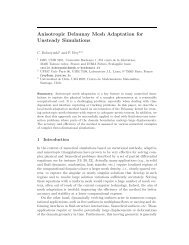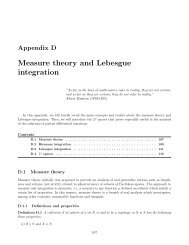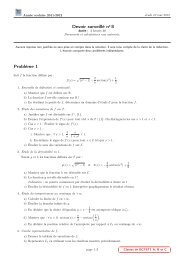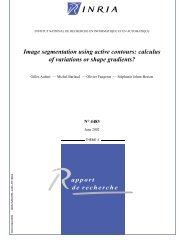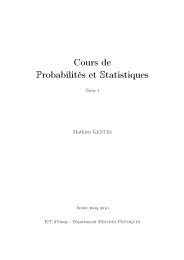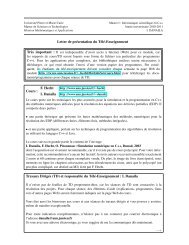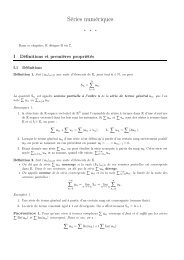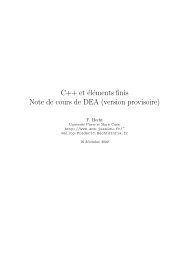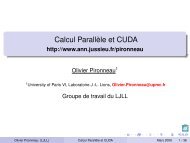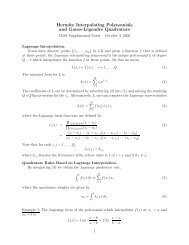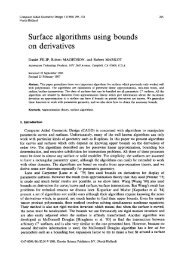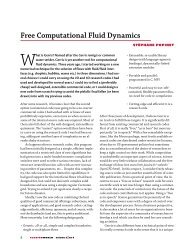Couples de variables aléatoires
Couples de variables aléatoires
Couples de variables aléatoires
You also want an ePaper? Increase the reach of your titles
YUMPU automatically turns print PDFs into web optimized ePapers that Google loves.
4 Lycée CHATEAUBRIAND - BCPST 1B<br />
III. Variable aléatoire fonction <strong>de</strong> <strong>de</strong>ux <strong>variables</strong> <strong>aléatoires</strong><br />
1. Loi d’une variable aléatoire fonction <strong>de</strong> <strong>de</strong>ux <strong>variables</strong> <strong>aléatoires</strong><br />
Définition 6. Soient (X, Y ) un couple <strong>de</strong> <strong>variables</strong> <strong>aléatoires</strong> et u : R 2 −→ R une application. On<br />
définit la variable notée u(X, Y ) par :<br />
u(X, Y ) : Ω −→ R<br />
ω ↦−→ u X(ω), Y (ω) .<br />
Proposition 4. La loi <strong>de</strong> Z = u(X, Y ) est donnée par par :<br />
∀ z ∈ Z(Ω), P(Z = z) = <br />
P [X = x] ∩ [Y = y] .<br />
(x,y) | u(x,y)=z<br />
2. Cas particulier <strong>de</strong> la somme <strong>de</strong> <strong>de</strong>ux <strong>variables</strong> <strong>aléatoires</strong><br />
Proposition 5. Soient (X, Y ) un couple <strong>de</strong> <strong>variables</strong> <strong>aléatoires</strong>. La loi <strong>de</strong> Z = X + Y est donnée par<br />
par :<br />
∀ z ∈ Z(Ω), P(Z = z) = <br />
P [X = x] ∩ [Y = y] .<br />
(x,y) | x+y=z<br />
Exercice 1. On effectue <strong>de</strong>ux tirages successifs et sans remise dans une urne contenant 4 boules<br />
numérotées <strong>de</strong> 1 à 4. On note X le plus petit <strong>de</strong>s numéros tirés et Y le plus grand.<br />
En utilisant la loi conjointe du couples (X, Y ), déterminer la loi <strong>de</strong> Z = X + Y .<br />
Théorème 3. Soient X ↩→ B(m, p) et Y ↩→ B(n, p) <strong>de</strong>ux <strong>variables</strong> <strong>aléatoires</strong> indépendantes.<br />
Alors,<br />
X + Y ↩→ B(m + n, p).<br />
3. Espérance d’une variable aléatoire fonction <strong>de</strong> <strong>de</strong>ux <strong>variables</strong> <strong>aléatoires</strong><br />
Théorème 4 (Theorem <strong>de</strong> transfert). Soient (X, Y ) un couple <strong>de</strong> <strong>variables</strong> <strong>aléatoires</strong> réelles sur<br />
(Ω, P(Ω), P) telles que X(Ω) = {x1, . . . , xn} et Y (Ω) = {y1, . . . , yp} et u : R 2 −→ R une application.<br />
Alors,<br />
E(u(X, Y )) = <br />
1≤i≤n<br />
1≤j≤p<br />
u(xi, yj) P [X = xi] ∩ [Y = yj] =<br />
n<br />
i=1<br />
p<br />
u(xi, yj)pi,j =<br />
Exemple 7. Retour à l’exercice précé<strong>de</strong>nt. On recherche <strong>de</strong> l’espérance <strong>de</strong> Z = XY .<br />
Proposition 6. Soient X, Y <strong>de</strong>s <strong>variables</strong> <strong>aléatoires</strong> réelles et a, b <strong>de</strong>s réels. Alors,<br />
On dit que l’espérance est linéaire.<br />
j=1<br />
E(aX + bY ) = aE(X) + bE(Y ).<br />
p<br />
j=1<br />
n<br />
i=1<br />
u(xi, yj)pi,j.



